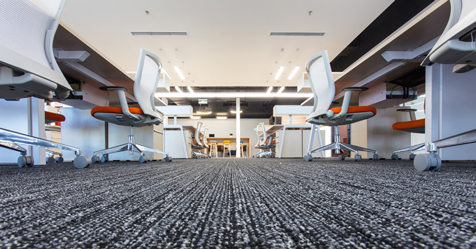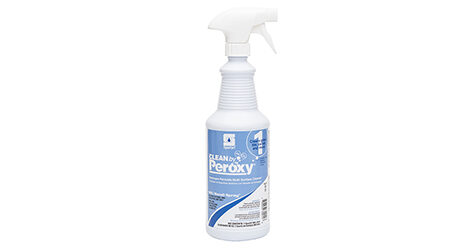Each year thousands of people are injured as a result of a slip and fall when entering a building entrance, and the first line of defense that most building owners employ is entrance carpet matting.
Although entranceway matting can play a significant role in preventing accidental slips by removing moisture from pedestrian footwear, they often contribute to trips and falls when buckled, curled or flipped over.
Walkway Safety Standards
In 2012, the American National Standards Institute (ANSI) B101 committee on slip, trip and fall prevention released the latest in its line of walkway safety standards — The ANSI/NFSI B101.6-2012 Standard Guide For Commercial Entrance Matting In Reducing Slips, Trips And Falls.
This standard provides criteria for the selection, installation, inspection, care and maintenance of entrance mats and runners in commercial facilities in reducing slips, trips and falls and is directed to eliminating slip, trip and fall hazards such as soil, moisture, contaminants, edge treatments as well as the improper use of floor mats and runners.
The development of the ANSI/NFSI B101.6 standard is a direct result of the mission of the National Floor Safety Institute (NFSI) answering a need for consumer education to ameliorate the effects of falls, and it seeks to answer the perceived need for this standard to stem the growing number of slips and falls related to insufficient knowledge in the use of mats and runners in commercial establishments.
Robert J. Moran, chairman of the ANSI B101.6 sub-committee and chairman and chief executive officer (CEO) of Ludlow Composites, a manufacturer of commercial floor matting, states, “This standard not only covers where and how mats should be deployed, but also identifies the hazards associated with improper mat placement and use. We also believe that the standard will soon be adopted by the insurance industry and will serve as an important tool in preventing their insured’s growing mat related trip-and-fall problem.”
This standard was developed by a subcommittee of the NFSI B101 Main Standards Committee, national in scope, functioning under the procedures of the American National Standards Institute with the NFSI as the ANSI Accredited Standards Developer and included representatives from major floor mat manufacturers.
As the number of floor mat related trip-and-fall lawsuits continue, this groundbreaking new standard has set forth the industry standard of care for the proper use, maintenance and inspections of entranceway floor matting and will dramatically affect the way building owners now must maintain, inspect and select entranceway floor mats.
What’s In The Standard?
The scope and application of the ANSI/NFSI B101.6-2012 establishes “the criteria for the selection, installation, inspection, care and maintenance of entrance mats and runners in commercial facilities in reducing slips, trips and falls and pertains to the safe usage and applications, design, construction and quality criteria of floor mats and runners.”
Key sections of the standard include terms related to entranceway floor mats such as buckling, curling, ripping that are all defined as they apply to entrance matting as well as the different types of mats including wiper mats, wiper-scrapper mats, scraper mats, recessed well mats and lesser known types of mats such as foot grilles and tire tiles.
Section 3
Section 3 of the standard addresses the mat backings and their ability to prevent movement while placed on the floor.
It is recommended that mats have a “High-traction Backing” which references the NFSI 101-C Test Method for Measuring Dry TCOF of Floor Mat Backing Materials which currently is the only nationally recognized standard by which to measure the slip resistant qualities of a floor mat’s backing.
Mats that do not have a high-traction backing are more prone to movement, which, in-turn, can increase the risk of migration, buckling and curling which can contribute to a slip, trip and fall event.
A growing number of entrance mat manufacturers have submitted their products to the NFSI for certification.
Mats that are NFSI Certified as “High-traction” provide the user the assurance that the mat’s backing provides the highest level of slip resistance.
Section 5
Section 5 of the standard discusses the proper selection of matting as it relates to its placement and its intended purpose and defines four distinct areas including: Outdoor areas, vestibules, indoor locations and other areas.
When matting is located outside a building, mats should either be a recessed mat, a scraper or a wiper-scraper mat which can either be loose laid or permanently installed with a recessed well mat/foot grille.
It’s also important to note that the standard states that a matting selection for interior vestibules is based on the use of outdoor matting and that whena scraper mat is used outdoors, then the matting in the vestibule shall be a wiper-scraper or wiper only mat.
However, when a scraper mat is not used outdoors, the vestibule matting shall be either scraper only or wiper-scraper.
When a scraper is used outdoors, the matting indoors shall be a wiper-scraper or a wiper mat.
When no scraper mat is used outdoors, the indoor matting shall both scrape and wiper mats shall be the second mat at the entrance.
The standard further discusses the responsibility of the property owner or manager to “identify areas within their facility where there exists a potential hazard for slips, trips or falls and validate the level of potential hazard through the use of B101 standardized wet COF measurements.”
The NFSI has published a series of test methods, whereby the property owner can test their floors to ensure they are appropriate for use with floor matting.
Many slip and fall events occur as the result of “surfboarding” across a wet floor therefore making it important to ensure that the floor underneath the floor mat is clean and dry.
The standard states that is important that property owners and managers provide “careful review of measurement results indicates a hazard potential, specifically due to the involuntary presence of grit, moisture or dust, management shall place mats in those areas.”
Section 6
Section 6 states, “The facility management shall both select the proper matting and have sufficient matting in place” and speaks to the “Adequacy of Matting.”
It describes, “The governing factor in determining the adequacy of matting shall be the amount of soil removal. The flooring immediately following the matting shall be examined to confirm that the soil and moisture has been removed. If it hasn’t, either more matting or the proper selection of matting needs to be employed.”
According to a recent whitepaper prepared by the Windsor Company, a typical six-foot entrance mat will only remove 40 percent of soil and moisture, and it takes approximately 36 feet of matting to remove 99 percent of soil and moisture.
Sections 7 And 8
Sections 7 and 8 address the proper care and maintenance and the reduction of hazards related to matting which now require, “Mats shall not be used in any manner other than their intended purpose” and that “When mats ripple, curl or have torn edges the mats shall be removed from service and replaced with mats that lay flat and that if a mat buckles, either the condition that caused the mat to buckle shall be corrected or the mat shall be secured or removed from service and replaced.”
The standard further requires, “Mats shall be installed on a clean, dry floor and that they shall be placed as to not overlap each other. Where mats do not lie flat, the mat shall be secured to the floor so that it lies flat or removed from service. Areas where mat migration may take place shall be monitored and the hazard corrected.”
The amount of matting to remove the soil is not static or fixed.
During inclement weather, additional matting should be utilized to supplement the dry weather matting
The use of larger mats whenever possible decreases the likelihood of mat migration due to the greater mass of the larger mats.
Property owners, facility managers and business owners are encouraged to familiarize themselves with the new ANSI/NFSI B101.6-2012 standard.
For more information or to download a copy, please visit the National Floor Safety Institutes website.



